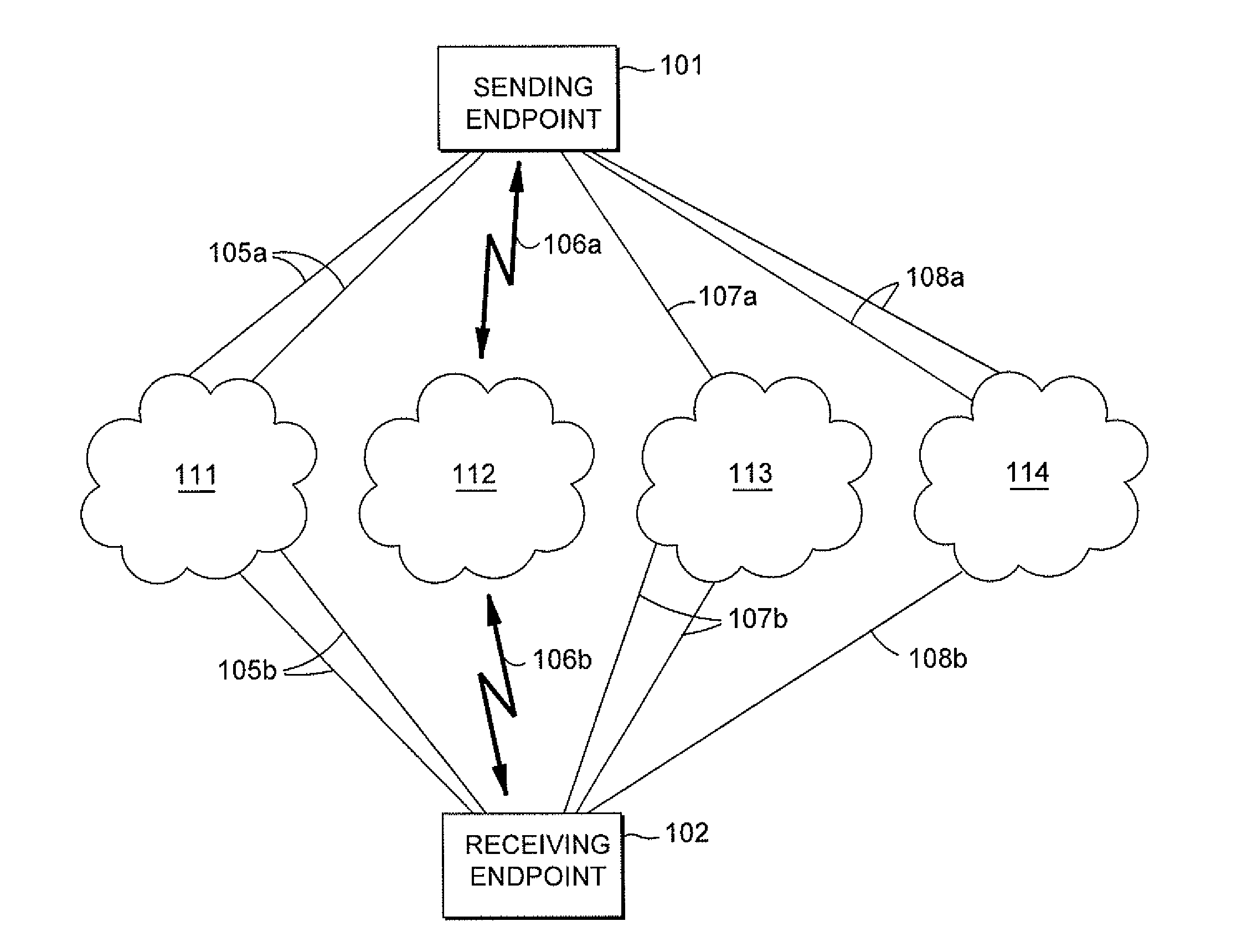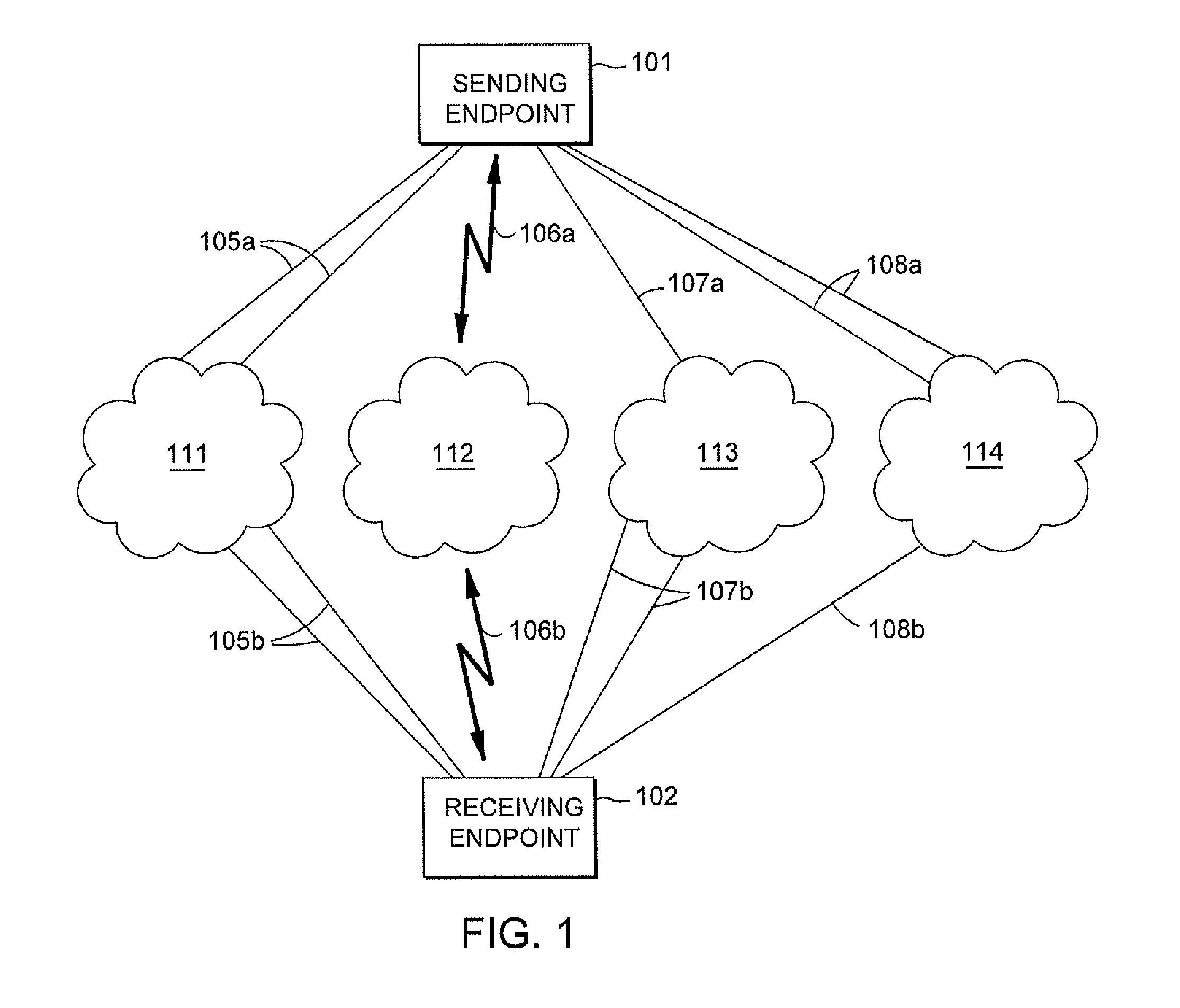[0008]By virtue of the foregoing arrangement, it is ordinarily possible to ensure delivery of important reference frames (i.e., intra-frame coded frames) of a streaming video, while reducing
delay of the streaming video and congestion within a network, which in turn reduces any possible degradation of the quality of the video stream. More specifically, because different ones of the intra-frame coded frames of the streaming video are sent over more than one of multiple communication channels having a connection-oriented protocol, the intra-frame coded frames are more likely to be successfully delivered than if the intra-frame coded frames were sent over a connectionless-oriented protocol. Also, the intra-frame coded frames are delivered more quickly and with less
delay since the intra-frame coded frames are sent over multiple communication channels. Furthermore, because different ones of less important frames (i.e., inter-frame coded frames) are sent over more than one of multiple communication channels having a connectionless-oriented protocol, any possible delay in streaming the video may be reduced because less data is sent using a connection-oriented protocol.
[0009]In addition, an advantageous effect may be obtained by virtue of the foregoing arrangement when there is
asymmetry between a
data capacity throughput upload speed on the sending endpoint and a
data capacity throughput download speed on the receiving endpoint. More specifically, because both the intra-frame coded frames and the inter-frame coded frames are split and sent over more than one
communication channel at the sending endpoint, it may be possible to provide a faster upload speed when the maximum upload speed is asymmetrically slower than the maximum download speed. Such
asymmetry is common, for example, in asymmetric digital subscriber lines (ADSL) and cable. Such an
advantage may be particularly evident in embodiments where the sending endpoint has multiple physical interfaces, since the speed of each individual interface is essentially accumulated into a larger effective speed.
[0010]In an example embodiment also described herein, when sending different ones of the plurality of intra-frame coded frames over more than one of the multiple communication channels, the intra-frame coded frames are sent in sequential order over sequentially selected ones of the multiple communication channels having a connection-oriented protocol in a round-robin fashion. Because different ones of the plurality of intra-frame coded frames are sent over more than one of the multiple communication channels having a connection-oriented protocol in a round-robin fashion, the data
throughput of the intra-frame coded frames may be increased, while maintaining the reliability of using communication channels having a connection-oriented protocol.
[0011]In another example embodiment described herein, when sending different ones of the plurality of intra-frame coded frames over more than one of the multiple communication channels, an amount of intra-frame coded frames sent over each of the multiple communication channels is proportional to a
data capacity throughput of each of the multiple communication channels compared to a total data capacity throughput of the multiple communication channels. For example, if a data capacity throughput of a first one of the multiple communication channels is 100 Mb / s, and a data capacity throughput of a second one of the multiple communication channels is 50 Mb / s, then roughly ⅔ of the intra-frame coded frames should be sent over the first
communication channel, and roughly ⅓ of the intra-frame coded frames should be sent over the second
communication channel. Because an amount of intra-frame coded frames sent over each of the multiple communication channels is proportional to a data capacity throughput of each of the multiple communication channels, the intra-frame coded frames may be delivered in an efficient manner by utilizing the difference in data throughput capacity of each of the multiple communication channels.
[0012]In yet another example embodiment described herein, when sending different ones of the plurality of intra-frame coded frames over more than one of the multiple communication channels, each of the plurality of intra-frame coded frames is split into multiple data packets, and different ones of the multiple data packets are sent over the multiple communication channels. In addition, in this example embodiment, an amount of the multiple data packets of the intra-frame coded frames sent over each of the multiple communication channels may be proportional to a data capacity throughput of each of the multiple communication channels compared to a total data capacity throughput of the multiple communication channels. Because each of the intra-frame coded frames is split into multiple data packets, and different ones of the multiple data packets are sent over multiple communication channels, the intra-frame coded frames may be delivered in an efficient manner by further utilizing the difference in data capacity throughput of each of the multiple communication channels. More specifically, the different data capacity throughputs of each of the multiple communication channels are further utilized because the size of data packets being sent is reduced, which in turn allows a more accurate apportionment of such data sent over a communication channel, based on a data capacity throughput of the communication channel.
 Login to View More
Login to View More  Login to View More
Login to View More 


